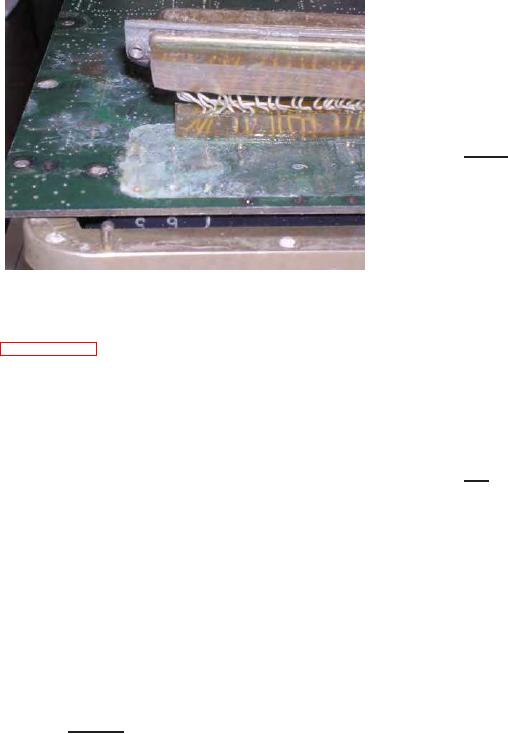
01 March 2005
NAVAIR 01-1A-509-1
TM 1-1500-344-23-1
TO 1-1-689-1
copper wire. This problem is compounded because
the wire insulation prohibits detection of breaks in the
silver plating until damage is extensive. This "red
plague" is readily identifiable by the presence of a
brown-red powder deposit on the exposed copper.
Silver plating over nickel plate does not exhibit the red
plague phenomenon.
3-10.12. GOLD. Traditionally considered the best
coating for corrosion resistance and solderability, gold
is used on printed circuits, semiconductors, leads, and
contacts. Gold is usually applied in a thin layer over
nickel, silver, or copper. Gold is a noble metal (pure
metal in nature) and does not normally corrode; however,
a slight deposit will appear as a darkening of reflecting
surfaces. Tarnish removal is critical on gold components
Figure 3-29. Corroded Circuit Card
because of the very thin coatings used. Gold plated over
silver or copper in thin layers accelerates corrosion over
the less noble metals (silver or copper). This occurs at
corrosion products on the corroded part (see
pores or pinholes in the gold. This corrosion is readily
Figure 3-29). Sometimes copper or copper alloy
identified as darkening of the silver or blue-green deposits
surfaces tarnish to a dull gray-green color (patina) and
on the copper. "Purple plague" is a brittle gold-aluminum
the surface will remain relatively smooth. This
compound formed when bonding gold to aluminum.
discoloration is the result of the formation of a fine-
The growth of such a compound can cause failure in
grained, airtight copper oxide crust. This crust offers
microelectronic interconnection bonds.
good protection for the underlying metal in ordinary
situations. However, exposure of copper and copper
3-10.13. TIN. The use of tin in solder is a well-known
alloys to moisture or salt spray causes the formation of
application. However, tin plating is also common on
blue-green salts, indicating active surface corrosion,
avionic RF shields, filters, crystal covers, and automatic
which should be removed. When coupled with most
switching devices. Tin has the best combination of
metals used in aircraft construction, copper is the less
solderability and corrosion resistance of any metallic
active metal and greatly accelerates corrosion of iron,
coating. However, tin has a tendency to grow "whiskers"
steel, aluminum, and magnesium. Examples are usually
on tin plated wire and other plated applications.
found in electrical components and in areas where
copper bonding strips or wires are fastened to an
3-11. DEGRADATION OF NON-METALS. Non-
aluminum chassis or structural components. Protective
metallic materials (plastics, elastomers, paints and
paint coatings are seldom required because of the
adhesives) are not subject to electrochemical corrosion,
inherent resistance of the metal. However, paint finishes
since ions are not easily formed from non-metallic
may be applied for decorative purposes or if the normal
materials and since the electrical conductivity of non-
tarnish or green patina on the copper is objectionable.
metals is extremely low. The degradation of non-metals
depends on the chemical makeup of the material and
3-10.11. SILVER. Silver is used as a plating material
the nature of the environment. In general, aircraft non-
over copper in waveguides, miniature and
metallic materials are selected for their performance
microminiature circuits, wires, contacts, high frequency
properties (flexibility, transparency, strength, electrical
cavities, tank circuits, and RF shielding. Silver does not
resistance). Also, resistance to heat, impact, abrasion,
corrode in the ordinary sense, although it will tarnish in
ultraviolet radiation, moisture, ozone and other
the presence of sulfur. The tarnish appears as a brown
detrimental gases, as well as operational fluids such
to black film. The tarnish is silver sulfide and may or
as hydraulic fluid, lubricants, cleaners, and deicing
may not be detrimental to circuit electrical
fluids, must be considered. However, the use of
characteristics, depending on the application. When
unauthorized maintenance chemicals and procedures
silver is plated over copper there can be an accelerated
can accelerate degradation. In almost all cases, the
corrosion of the copper. This occurs through galvanic
deterioration of a nonmetallic material permits moisture
action at pinholes or breaks in the silver plating. One
intrusion. This creates physical swelling, distortion,
example of this is the deterioration of silver plated

